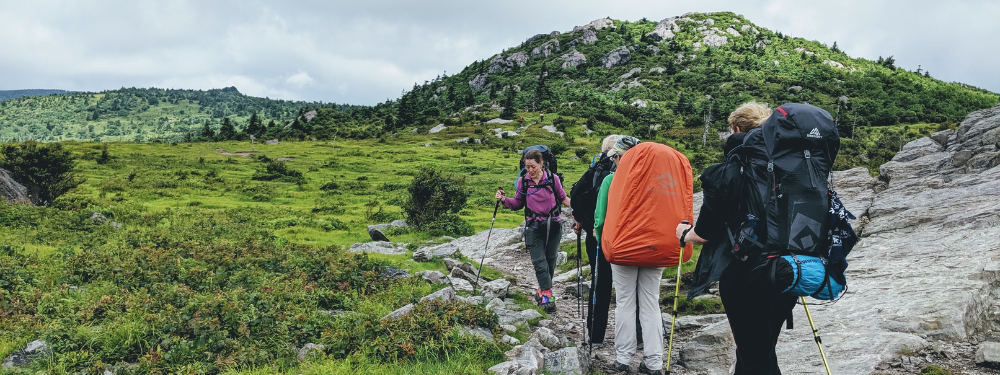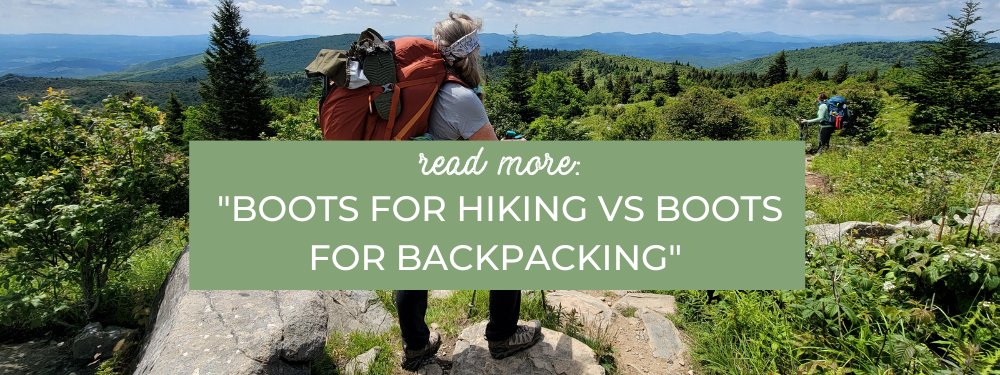Today, we're condensing our decades of hiking and backpacking experience into one blog post so you can hike with confidence, either alone or with a group!
To find the right hiking trip for you, check out our Trip Calendar here!
Top 10 Hiking Tips for Beginners
1. Hike at Your Own Pace
If you’re like many other women, the first introduction you may have had to hike is with an experienced companion who sets off quickly, leaving you gasping for breath. Inevitably, this leads you to decide that hiking isn't fun. Being forced to hike at a slower pace than you want can also be uncomfortable and often discourages people from going on group hikes. The most important hiking skill you can learn is to hike at your own pace, even in a group.
How do you know what that pace is? You can comfortably sustain your pace without ever stopping to catch your breath, even when going up a steep hill. At the right pace, your body feels good, your breathing deep but still comfortable, and your muscles working but not overtaxed. You may still need to stop for an occasional break, but at the right pace, you should feel like you can go forever.
2. If You're a Beginner Hiker, Start with Beginner Hikes
Because hiking is just a variation of walking, and we all walk all the time, you may assume that the only thing that determines what hike you do is how fit you are. Not true. Every time you hike, your neuromuscular system learns how to place your foot, keep your balance, and what adjustments the upcoming terrain will require. The more you hike, the more all of this becomes unconscious and automatic, just like driving a car. The biggest difference between an experienced and an inexperienced hiker Is not how fast they hike but how comfortable they feel going downhill or hiking on uneven ground.

3. Stay Well Hydrated
Sometimes, women hesitate to drink as much water as they need to when hiking because elimination is more challenging for them than it is for men. This is a huge mistake. Not being adequately hydrated can lead to headaches, fatigue, and irritability, all of which can make you more accident-prone. An easily accessible water bottle is adequate, but a hydration system with a tube that enables you to sip water while hiking is even better. Not having to stop and put your pack down means that you are more likely to drink before you’re thirsty, a key to staying well hydrated.
4. Take Care of Hot Spots When You Feel Them
Many times, women who start feeling "hot spots" on their feet, those small areas of heat and discomfort, delay taking care of them because they don't want to slow the group down. This is an understandable but big mistake, as hot spots can become blisters in five minutes – and blisters are much more difficult to treat. The best treatment is to apply some tincture of Benzoin over the affected area. Benzoin protects the skin, dries it, and provides a sticky surface for tape. When tacky, cover the painted area with some moleskin, preferably with a circle cut out (making it look like a doughnut), and place it over the area. The open part of this circle should go over the blister so that the edges "cushion" it against more friction.
5. Make Sure Your Boots Fit Well
Many women have "low volume" feet, meaning feet that are narrow and skinny with a very narrow forefoot and heel area and a low instep. It makes getting boots that fit quite challenging, and ill-fitting boots lead to ankle injuries and blisters. The most important step is to buy your boots from a store that has salespeople who know how to fit them. If they simply bring out several pairs and ask you how they feel, walk out. Superfeet insoles provide support and add volume, which can make a huge difference. Click below to read more about choosing the right pair of hiking boots for your next hiking or backpacking adventure:
6. Don’t Wear Cotton Clothing
Except when hiking in a hot, dry climate, cotton clothing should be avoided- including cotton bras. Cotton absorbs sweat and thus stays saturated. Having wet and cold clothing next to the body can cause rapid chilling. Bras are particularly bad because they are designed to be skintight. Two solutions: don’t wear one and have the first layer be a fabric that “wicks” sweat away; if you are uncomfortable going without a bra, another good choice is to buy one made of wicking material.
7. Put on a Layer as Soon as You Take a Break
It's not uncommon to be a little overheated when you stop for a break, and it's tempting to enjoy cooling off. This is fine as long as it is warm. But putting on a layer as soon as you stop is essential if your hiking has taken you up a hill to cooler temperatures and perhaps some wind. The best is something with the wind-blocking ability (Gore-Tex rain jackets are great for this). Otherwise, once your body temperature starts to drop, it keeps going- and pretty soon, you're colder than you want to be. Wearing cotton, including a cotton bra, makes this even worse and increases the likelihood of getting dangerously chilled.
8. Take Good Care of Your Knees
It is unfortunate that arthritis of the knees is associated with age and that women are more likely to develop it than men. In addition, women are more likely to suffer knee injuries, particularly to their anterior cruciate ligament (ACL). The reasons for this are not completely known – hormones, musculature, and skeletal structure all seem to play a role. Trekking poles are extremely helpful for removing pressure from your knees and making falls less likely to happen. Here are some other things you can do as well:
-
Before the trip:
Build up your leg strength. Before your hiking trip, start doing squats and lunges with gradually increasing weight. Doing these exercises incorrectly can worsen your knees, so ensure you get proper instruction. However, strengthening the muscles that stabilize the knee joint can do wonders for preventing knee pain. -
During the trip:
Keep your legs loose. Some women have a tendency to walk stiff-legged, especially on a steep trail where they are anxious. The more you can consciously keep your legs a little flexed at the knee, the less pounding your knees get. Turn sideways on high steps. This allows you to use the stronger muscles in your legs to step down more slowly and not hit the ground as hard with your foot, thereby decreasing the pressure on your knee. Walk slightly pigeon-toed. This loosens the ligaments on the inside of your knee, which helps decrease knee pain.
9. Learn How to Use Trekking Poles
All the guides at Adventures in Good Company are huge fans of trekking poles: they are your best friend for preventing knee pain or for keeping it from getting worse. However, there are a number of tricks to using poles that will make them much more comfortable and efficient. We teach these tricks on our hiking trips, but you can also learn more about them by reading this blog.
10. Follow Proper Trail Etiquette
Like everything in life, there are some all-too-often unspoken norms that dictate hiking etiquette. Feeling more comfortable in a new setting is always easier when you have a clear idea of the basic “rules.” Walking on the right, giving uphill hikers the right-of-way, yielding to horses and bikers, and leaving no trace are easy ways to make sure you are respecting other hikers and the natural environment. Knowing trail etiquette before you hike will boost your confidence and make it easier to build on-trail relationships!

Disclaimer: This blog post features some affiliate links. This means AGC gets a small commission if you make a purchase (at no extra cost to you). Thank you for the support!




